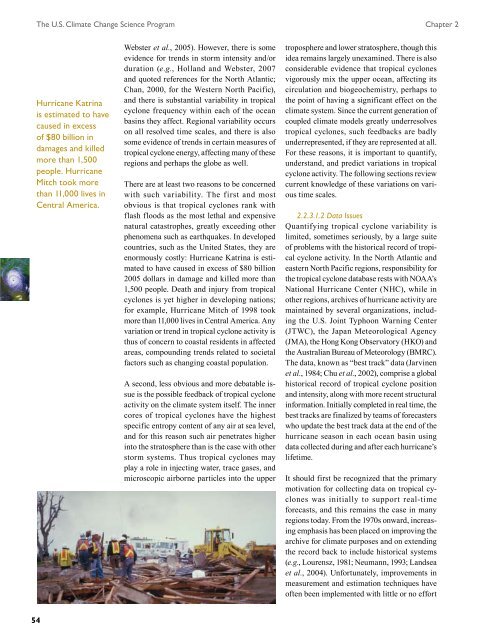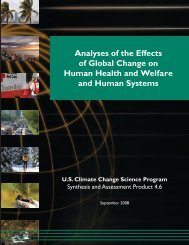Weather and Climate Extremes in a Changing Climate. Regions of ...
Weather and Climate Extremes in a Changing Climate. Regions of ...
Weather and Climate Extremes in a Changing Climate. Regions of ...
You also want an ePaper? Increase the reach of your titles
YUMPU automatically turns print PDFs into web optimized ePapers that Google loves.
The U.S. <strong>Climate</strong> Change Science Program Chapter 2<br />
Hurricane Katr<strong>in</strong>a<br />
is estimated to have<br />
caused <strong>in</strong> excess<br />
<strong>of</strong> $80 billion <strong>in</strong><br />
damages <strong>and</strong> killed<br />
more than 1,500<br />
people. Hurricane<br />
Mitch took more<br />
than 11,000 lives <strong>in</strong><br />
Central America.<br />
54<br />
Webster et al., 2005). However, there is some<br />
evidence for trends <strong>in</strong> storm <strong>in</strong>tensity <strong>and</strong>/or<br />
duration (e.g., Holl<strong>and</strong> <strong>and</strong> Webster, 2007<br />
<strong>and</strong> quoted references for the North Atlantic;<br />
Chan, 2000, for the Western North Pacific),<br />
<strong>and</strong> there is substantial variability <strong>in</strong> tropical<br />
cyclone frequency with<strong>in</strong> each <strong>of</strong> the ocean<br />
bas<strong>in</strong>s they affect. Regional variability occurs<br />
on all resolved time scales, <strong>and</strong> there is also<br />
some evidence <strong>of</strong> trends <strong>in</strong> certa<strong>in</strong> measures <strong>of</strong><br />
tropical cyclone energy, affect<strong>in</strong>g many <strong>of</strong> these<br />
regions <strong>and</strong> perhaps the globe as well.<br />
There are at least two reasons to be concerned<br />
with such variability. The first <strong>and</strong> most<br />
obvious is that tropical cyclones rank with<br />
flash floods as the most lethal <strong>and</strong> expensive<br />
natural catastrophes, greatly exceed<strong>in</strong>g other<br />
phenomena such as earthquakes. In developed<br />
countries, such as the United States, they are<br />
enormously costly: Hurricane Katr<strong>in</strong>a is estimated<br />
to have caused <strong>in</strong> excess <strong>of</strong> $80 billion<br />
2005 dollars <strong>in</strong> damage <strong>and</strong> killed more than<br />
1,500 people. Death <strong>and</strong> <strong>in</strong>jury from tropical<br />
cyclones is yet higher <strong>in</strong> develop<strong>in</strong>g nations;<br />
for example, Hurricane Mitch <strong>of</strong> 1998 took<br />
more than 11,000 lives <strong>in</strong> Central America. Any<br />
variation or trend <strong>in</strong> tropical cyclone activity is<br />
thus <strong>of</strong> concern to coastal residents <strong>in</strong> affected<br />
areas, compound<strong>in</strong>g trends related to societal<br />
factors such as chang<strong>in</strong>g coastal population.<br />
A second, less obvious <strong>and</strong> more debatable issue<br />
is the possible feedback <strong>of</strong> tropical cyclone<br />
activity on the climate system itself. The <strong>in</strong>ner<br />
cores <strong>of</strong> tropical cyclones have the highest<br />
specific entropy content <strong>of</strong> any air at sea level,<br />
<strong>and</strong> for this reason such air penetrates higher<br />
<strong>in</strong>to the stratosphere than is the case with other<br />
storm systems. Thus tropical cyclones may<br />
play a role <strong>in</strong> <strong>in</strong>ject<strong>in</strong>g water, trace gases, <strong>and</strong><br />
microscopic airborne particles <strong>in</strong>to the upper<br />
troposphere <strong>and</strong> lower stratosphere, though this<br />
idea rema<strong>in</strong>s largely unexam<strong>in</strong>ed. There is also<br />
considerable evidence that tropical cyclones<br />
vigorously mix the upper ocean, affect<strong>in</strong>g its<br />
circulation <strong>and</strong> biogeochemistry, perhaps to<br />
the po<strong>in</strong>t <strong>of</strong> hav<strong>in</strong>g a significant effect on the<br />
climate system. S<strong>in</strong>ce the current generation <strong>of</strong><br />
coupled climate models greatly underresolves<br />
tropical cyclones, such feedbacks are badly<br />
underrepresented, if they are represented at all.<br />
For these reasons, it is important to quantify,<br />
underst<strong>and</strong>, <strong>and</strong> predict variations <strong>in</strong> tropical<br />
cyclone activity. The follow<strong>in</strong>g sections review<br />
current knowledge <strong>of</strong> these variations on various<br />
time scales.<br />
2.2.3.1.2 Data Issues<br />
Quantify<strong>in</strong>g tropical cyclone variability is<br />
limited, sometimes seriously, by a large suite<br />
<strong>of</strong> problems with the historical record <strong>of</strong> tropical<br />
cyclone activity. In the North Atlantic <strong>and</strong><br />
eastern North Pacific regions, responsibility for<br />
the tropical cyclone database rests with NOAA’s<br />
National Hurricane Center (NHC), while <strong>in</strong><br />
other regions, archives <strong>of</strong> hurricane activity are<br />
ma<strong>in</strong>ta<strong>in</strong>ed by several organizations, <strong>in</strong>clud<strong>in</strong>g<br />
the U.S. Jo<strong>in</strong>t Typhoon Warn<strong>in</strong>g Center<br />
(JTWC), the Japan Meteorological Agency<br />
(JMA), the Hong Kong Observatory (HKO) <strong>and</strong><br />
the Australian Bureau <strong>of</strong> Meteorology (BMRC).<br />
The data, known as “best track” data (Jarv<strong>in</strong>en<br />
et al., 1984; Chu et al., 2002), comprise a global<br />
historical record <strong>of</strong> tropical cyclone position<br />
<strong>and</strong> <strong>in</strong>tensity, along with more recent structural<br />
<strong>in</strong>formation. Initially completed <strong>in</strong> real time, the<br />
best tracks are f<strong>in</strong>alized by teams <strong>of</strong> forecasters<br />
who update the best track data at the end <strong>of</strong> the<br />
hurricane season <strong>in</strong> each ocean bas<strong>in</strong> us<strong>in</strong>g<br />
data collected dur<strong>in</strong>g <strong>and</strong> after each hurricane’s<br />
lifetime.<br />
It should first be recognized that the primary<br />
motivation for collect<strong>in</strong>g data on tropical cyclones<br />
was <strong>in</strong>itially to support real-time<br />
forecasts, <strong>and</strong> this rema<strong>in</strong>s the case <strong>in</strong> many<br />
regions today. From the 1970s onward, <strong>in</strong>creas<strong>in</strong>g<br />
emphasis has been placed on improv<strong>in</strong>g the<br />
archive for climate purposes <strong>and</strong> on extend<strong>in</strong>g<br />
the record back to <strong>in</strong>clude historical systems<br />
(e.g., Lourensz, 1981; Neumann, 1993; L<strong>and</strong>sea<br />
et al., 2004). Unfortunately, improvements <strong>in</strong><br />
measurement <strong>and</strong> estimation techniques have<br />
<strong>of</strong>ten been implemented with little or no effort




